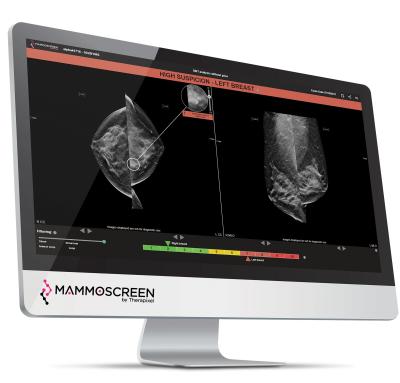In a major boon for the battle against breast cancer—which recently overtook lung cancer as the world’s most common form of cancer—artificial intelligence technologies designed to automatically detect signs of the disease in X-rays are cropping up at an astounding rate.
One comes from Therapixel, the developer of AI-powered MammoScreen, which has already been cleared by the FDA to highlight potentially cancerous lesions in mammograms.
With the stateside clearance in tow, France-based company has set its sights on expanding MammoScreen’s reach across the U.S.—now helped along by a 15 million euro ($15.6 million) funding round.
French venture capital investors Crédit Mutuel Innovation and CapHorn led the series B financing. They were joined by a handful of new and existing backers, including Verve, Sham Innovation Santé, Omnes, IT-Translation, M-Capital and Région Sud Investissement.
In addition to making MammoScreen more ubiquitous in cancer screening across the U.S.—by adding new sales and support staff and ramping up its commercial activities in the region, according to CEO Matthieu Leclerc-Chalvet—Therapixel said it would also use the funding to continue fine-tuning its AI technology and adding new features to the MammoScreen platform.
“We will accelerate the launch of a new generation of AI that will allow women to benefit from an earlier detection with less anxiety and radiologists to be assisted in the ever-growing demand for imaging,” said Pierre Fillard, the startup’s founder and chief scientific and technology officer. “We will also advance the regulatory and clinical developments that will solidify our leading position as the AI solution of choice for radiologists reading mammography.”
Currently, MammoScreen uses machine learning AI to analyze both 2D and 3D mammograms, then generates a score between one and 10 indicating the likelihood that a specific image shows signs of breast cancer.

That’s a similar approach to the one taken by Therapixel’s fellow AI developers, including Paige, Ibex, Whiterabbit and many more, all of which have built platforms able to automatically look for cancer in a tissue slide or X-ray scan.
However, the platform’s resulting analyses differ from those of its competitors in a few key ways. For one, it highlights only potentially cancerous areas of the breast, rather than all of its benign and malignant findings, allowing radiologists and oncologists to move much more quickly in looking over the results and developing a plan of attack.
For another, those points are identified with only a transparent circle rather than the heat map style of analysis that’s popular with AI developers aiming to show the severity of a cancerous lesion, but which can also obscure the lesion itself.